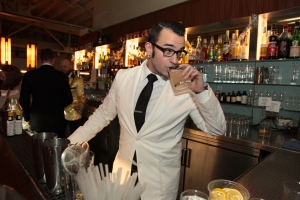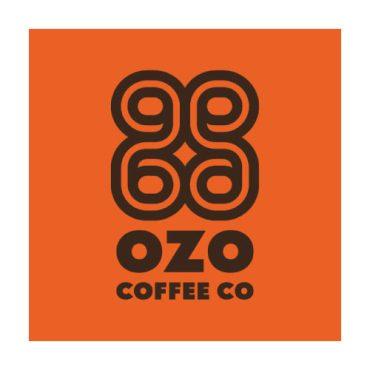Craft distillers, mixologists behind the artisan mixer boom
By John Lehndorff
(This feature originally appeared in Cheese Connoisseur Magazine, via John Lehndorff’s blog.)

There is one shelf at your local wine and spirits merchant that might as well have an invisibility cloak over it. Most of us ignore it on the way to the seltzer water and Bloody Mary mix. In the past, only savvy home bartenders stopped at the bitters shelf to acquire the secret ingredients for accurate “Mad Men“-era highballs.
That obscurity and mystery won’t last much longer. Already the mixers department is undergoing a craft makeover.
Those lonely paper-wrapped bottles of Angostura Bitters along with Peychaud’s, an essential ingredient in New Orleans’ iconic Sazerac, have been joined by a veritable apothecary of new brands and on-trend flavors. They range from Scrappy’s Celery Bitters and Fee Bros. Black Walnut Bitters to Urban Moonshine Organic Gluten-Free Bitters and Woodford Reserve Spiced Cherry Bourbon Barrel Aged Cocktail Bitters.
Beyond bitters, those shelves also getting crowded with other a wild assortment of mixology additions including fruit, herb and spice syrups, tonics and even “shrubs” or drinking vinegar.
For star bartender Sean Kenyon these new artisan bitters are welcome additions to his flavor arsenal. He stocks 12 varieties of bitters at Williams & Graham, his popular speakeasy in Denver that was a semi-finalist for the James Beard Award. The huge cocktail menu there also includes more than 30 bitters-oriented choices under the Vermouth, Aperitif, Digestif and Amaro banner.
Growing up in a bar-owning family in Patterson, New Jersey, Kenyon’s first encounter with bitters was NOT a positive one. “I thought Angostura was steak sauce and when I was 8 years old I put it on my hamburger. I was pretty upset that I ruined that burger,” he says.
Later, as he was learning to mix a classic Manhattan from a “Mr. Boston” recipe, he understood the timeless appeal. “I was blown away by the difference bitters make – it’s the salt of cocktails,“ he says.
Despite the name, bitters don’t necessarily taste impossibly bitter, but they are intensely flavored. Most cocktail recipes measure bitters in dashes but it aids the balancing act that is a well-made cocktail and add citrus, herbal, floral and vegetal notes. Bitters are the pizzazz you don’t miss in a cocktail until it’s not there.
The terminology of bitters and related ingredients can be a little arcane. Bitters are always a blend of flavors, a mix of extracts that aren’t sweetened. Extracts are singular infusions of an ingredient like coffee or hibiscus. They can be very precise tastes, I.e., Thai pepper versus ancho chile. Some liqueurs are sweetened bitters. Dilute bitters and they become aperitifs (before dinner to stimulate appetite) and digestifs (after dinner to settle tummies).
In use for centuries for medicinal purposes, bitters includes tonic water infused with quinine which aided the fight against malaria and also made possible the invention of the gin and tonic.
The boom in the past five years in small-batch bar ingredients followed naturally from the microbrew phenomenon and the opening of hundreds of craft distilleries across the United States. The vast majority of the new distilleries were producing gin which is really just a diluted alcohol extract of juniper berry and botanicals so it wasn‘t a huge leap to create bitters.
A cursory glance at amazon.com and other online sites shows dozens of varieties of craft bitters and related cocktail ingredients available to bartenders. “Many people started making and bottling all kinds of bitters,” Kenyon says. The result was that some bitters clearly jumped the shark, flavor-wise. “Some of the bitters – things like sunflower hops – could only be used in a couple of drinks,” he says, and the bottle would sit around for months.
One of the new wave that Kenyon swears by is Barkeep Baked Apple Bitters from Greenbar Craft Distillery, the first to open in Los Angeles since the repeal of Prohibition. He praises its caramelized apple and baking spice accents that enhance whiskey- and bourbon-based cocktails.
Greenbar produces a full line of organic gin, vodka, tequila, whiskey, rum and liqueurs. When inquiries came in about making craft bitters, the distillery took a crowd sourcing approach, says Greenbar marketing manager Mimi Mitrius. “We held a competition and bartenders from across the country sent in samples of their bitters,“ The bitters that emerged victorious from the blind judging was bottled and then the formulation is added to the company’s roster. A portion of the profits go back to the bartender. The Barkeep series now includes Baked Apple, Chinese, Fennel and Lavender Bitters. The next bitters competition is being planned for 2016, she says.
Beyond cocktails, this new spice rack for bars and restaurants also allows mixologists to create complex adult beverages for non-drinkers tired of soda and a lime or Shirley Temples.
On occasion the bitters also sneak into the kitchen, Mitrius says. “Our Baked Apple Bitters are great on vanilla ice cream, and the Saffron Bitters gets used in chicken dishes as in Indian cuisine.”
In the James Beard Award-winning volume “Bitters: A Spirited History Of A Classic Cure-All With Cocktails, Recipes, And Formulas“ (Ten Speed), Brad Thomas Parsons makes a good the case that bitters can enhance food in the same way it transforms drinks. Among the recipes he offers are Hot & Sticky Bitter Wings and Bitters Chocolate Malted Pudding.
Sean Kenyon says that a new generation of cocktail enthusiasts are asking bartenders a lot of questions about how to make cocktails properly. “They shoot a lot of cell phone photos. They want to make sure they are doing it right,” he says. Some are even crafting bitters at home and experimenting with flavors. If that seems like too much trouble, remember that these are the kind of folks who mold round ice cubes for their cocktails using mesquite-smoked water.
Just as craft beer is pricier than Bud and craft gin has a higher price tag than “well” gin, artisan bitters do cost a bit more. It’s an affordable luxury since the cost per dash is quite modest. Experts still can’t define exactly how large a “dash” is, so making a perfect Manhattan is still as much art as craft and that’s why it’s so much fun.
RESOURCES
Williams & Graham, 3160 Tejon St., Denver
Cocktail Punk
http://scrappysbitters.com
http://bittermens.com
kingcocktail.com
greenbar.biz
Five recommended artisan bitters
Sean Kenyon, named American Bartender of the Year at the 2014 Spirited Awards, believes in bitters and stocks a dozen varieties at the bar at Denver’s Williams & Graham. Here are a few of his favorites beyond the must-haves: Angostura Bitters and Peychaud’s.
Cocktail Punk Cherry Bitters: “Strong cherry with clove spice notes.”
Scrappy’a Aromatic Bitters: “Prominent baking spices. Great in classic whisky cocktails.”
Bittermans Xocolatl Mole Bitters and Hellfire Habanero Shrub: “The Xocolatle brings a dry cocoa note that I love. It’s almost Cocoa Puffs. Hellfire is a great way to add spice to a cocktail without sugar.”
Dale DeGroff’s Pimento Aromatic Bitters: “One of the best out there. Strong allspice.”
Greenbar Barkeep Organic Baked Apple: “Like a warm baked apple pie. Great with cognac or gin.”
Winning cocktail recipe is all about the bitters
Sean Kenyon won $10,000 in a cocktail competition for this formula which uses a full ounce of Angostura Bitters
The 10K Flip
2 ounces Domaine de Canton
1 ounce Angostura Bitters
1 half orange wheel
1/2 ounce orgeat
1 whole egg
In mixing tins, shake all ingredients without ice to emulsify. Add ice and shake vigorously. Strain into a sherry glass. Grate nutmeg over the top.
Matching cheese and cocktails
Here are some cocktails and cheese pairings from Lisa Futterman of Pastoral Artisan Cheese, Bread & Wine in Chicago.
Bourbon Old Fashioned – The nutty and sweet flavors of Alpine-styled cheese like Comte play well with the vanilla, orange and caramel notes of the bourbon with the spiciness of the bitters tying everything together.
Peruvian Pisco Sour – We decided to pair dry on dry for this one, Capriole’s Sofia is a tangy ash ripened goat’s cheese with a velvety texture and earthy notes. It melts seamlessly into the richness of the egg white and the acidity of the cocktail works well to refresh the palate.
Sazerac – An herbal, earthy, funky cheese like Morbier softens the blow of the high booze content in the Sazerac while the cheese’s funky mushroom flavors and grassy tones fit right in with the absinthe wash.
Bloody Mary – To play off this American classic we chose the Mareike Smoked Cumin Gouda. The smokiness of the cheese goes well with the tomato component as well as the spice.
Manhattan – The elegance of Ossau Iraty, a sheep’s milk cheese that is the definition of balance which compliments the finesse and richness of the classic Manhattan.



















